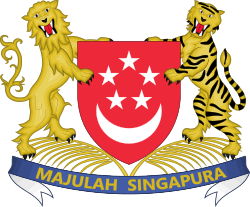Singapore Police Force
The Singapore Police Force (Abbreviation: SPF) is the principal law enforcement agency within the Republic of Singapore.[3] It was formerly known as the Republic of Singapore Police (RSP).
 | |
| Abbreviation | SPF |
| Motto | "Setia dan Bakti"[1] (Malay) "Loyalty and Service" |
| Agency overview | |
| Formed | 1820 |
| Jurisdictional structure | |
| National agency | Singapore |
| Operations jurisdiction | Singapore |
| General nature | |
| Headquarters | 28 Irrawaddy Road, New Phoenix Park, Singapore 329560 |
| Regular officers | 9,591[2] |
| Civilian officers | 1,369 |
| Elected officers responsible |
|
| Agency executives |
|
| Parent agency | Ministry of Home Affairs |
| Staff Departments | 20
|
| Specialist & Line units | 18
|
| Facilities | |
| NPCs/NPPs | 97 |
| Police boats | 61 |
| Website | |
| police | |
The SPF is an uniformed organisation under the purview of the Ministry of Home Affairs (MHA). The mission of the SPF is to prevent, deter and detect crime to ensure the safety and security of Singapore. This is done through its focus on the five broad areas of Police work: Frontline Policing, Counter and E-services, Community Engagement, Investigation, and Public Security & Order. The vision of the SPF is: A Force for the Nation – To Make Singapore the Safest Place in the World.[4] The values are courage, loyalty, integrity and fairness (C.L.I.F.): – willing to risk lives, if necessary, in order to safeguard society, have the moral courage to seek and speak the truth, and to set wrongs right; – loyal to the nation, to the Home Team, to the SPF community, and to own beliefs and ideals; – never forsake our ethics in order to attain our objectives, actions are guided by principle, not expediency; – fair in dealings with people, irrespective of their race, religion, gender, age, standing in life and irrespective of whether they are victims, suspects or convicts, also apply the same standard to the members of the SPF.[5]
The organisational structure of the SPF is split between the staff and line functions, roughly modelled after the military. There are currently sixteen staff departments, four specialist staff departments, and eighteen specialist and line units, including seven land divisions. The headquarters is located in a block at New Phoenix Park in Novena, adjacent to a twin block occupied by the Ministry of Home Affairs.[6]
History
The Singapore Police Force is as old as modern Singapore. The Force was formed in 1820,[7] with a skeleton force of 11 men under the command of Francis James Bernard, son-in-law of William Farquhar. With no background nor knowledge on policing, Bernard had to work from scratch, as well as occasionally turning to Farquhar for help. In addition, he held multiple roles as magistrate, chief jailer, harbour master, marine storekeeper, as well as personal assistants to Farquhar. Farquhar informed Raffles that he had provisionally introduced licenses for opium and alcohol sales that would raise $650 per month, with $300 of this sum being used to run a small police department.[8]
As the department took form, Bernard became in charge of a Malay writer, one jailor, one jemadar (sergeant) and eight peada (constables) by May 1820.[7] Raffles approved these arrangements by August 1820 and cemented the formal establishment of a police force in Singapore.[9] Manpower constraints meant that the men had to perform a wide range of roles, and required the help of headmen among the various ethnic communities to maintain orderliness on the streets, all the more possible as the communities lived in segregated areas around the city.
This partnership with the community was in line with Sir Stamford Raffles' vision of a thriving colony largely self-regulated by local social structures, with the British masters administrating it via indirect rule. The large influx of migrants from China, however, began to test this system when the hands-off approach by the British allowed secret societies in Singapore to thrive. Although originally formed with legal intentions of community bonding and the provision of assistance to fellow migrants, these societies gradually became influential, competitive, and increasingly engaged in illegal activity including monetary extortion from the masses, the operation of gambling dens and the smuggling of illegal goods on top of more legal commercial operations to meet their financial needs.
Competition gradually heated up between large rival factions, such as that between the larger Ghee Hin Kongsi, the Ghee Hock Kongsi and the Hai San Kongsi. Murders, mass riots, kidnappings, arson, and other serious crimes became commonplace in the next four decades since the colony's founding. Faced with violent acts of crime which may involve thousands, such as the Chinese Funeral Procession Riots of 1846 involving 9,000 members from the Ghee Hin and Ghee Hock secret societies, the police force was woefully incapable of bringing the situation under control and often had to call in the army for assistance. The escalating number of serious crimes prompted the need for stronger legislation to deter would-be criminals. Singapore's first executions were thus held in the wake of the first criminal session on June 1828, when a Chinese and Indian were found guilty and convicted for murder.
Headed by Europeans and predominantly staffed by Malay and Indian officers, the force had little Chinese representation as to the military and policing professionals were traditionally shunned by the Chinese community, which therefore impaired policing efforts among the large Chinese populace. In 1843, the force comprised a sitting magistrate doubling up as a superintendent, three European constables and an assistant native constable, 14 officers and 110 policemen. With a total strength of no more than 150 men, the police were compelled to avoid direct intervention in these mass acts of violence, else risking almost total annihilation.
A repeat of this scenario occurred in 1851 when lingering displeasure against Roman Catholic ethnic Chinese erupted into major rioting leaving over 500 Chinese dead. The army was called in again, although it involved having to induct Indian convicts into military service almost overnight. In 1854, twelve consecutive days of violence sparked by a dispute between the Hokkiens and Teochews disrupted trade. This particular incident led to the formation of the military's Singapore Rifle Corps on 8 July 1854, the earliest predecessor of the Singapore Armed Forces' People's Defence Force today.
However, criminal violence was not merely in the domain of the ethnic Chinese. Rivalries between Malay princes and communities also often result in acts of violence, which prompted the passing of Singapore's first arms law in March 1823 restricting the right to bear arms to 24 of the Malay Sultan's followers. Nearly two centuries later, these anti-arms laws continue to be strictly enforced, resulting in a society relatively free from firearms-related criminal offences.[10]

The murder rate in Singapore is reportedly low.[11]
Organisational structure
Leadership
| Rank and appointment | Abbreviation | Office holder |
|---|---|---|
| Commissioner of Police | CP | Hoong Wee Teck[12] |
| Deputy Commissioner of Police (Policy) | DC(P) | Jerry See Buck Thye |
| Deputy Commissioner of Police (Investigations & Intelligence) | DC(I&I) | Florence Chua |
| Deputy Commissioner of Police (Operations) | DC(Ops) | Tan Hung Hooi |
Staff departments
| Department | Abbreviation | Area of responsibility | Ref |
|---|---|---|---|
| Administration & Finance Department | A&F | Administrative, finance and procurement services | [13] |
| Centre for Protective Security | CPS | Training and maintenance of protective security standards | [14] |
| Community Partnership Department | CPD | Community engagement and crime prevention | [15] |
| Inspectorate and Compliance Office | InCo | Internal audit and risk management | [16] |
| Internal Affairs Office | IAO | Handling of internal investigations | [17] |
| International Cooperation Department | ICD | Maintenance of relations with foreign law enforcement agencies as well as handling transnational and international police operations | [18] |
| Manpower Department | MPD | Human resource management and recruitment programmes | [19] |
| Operations Department | OPD | Responsible for operational matters including the development of doctrines and standard operating procedures; oversees the Police Operations Command Centre | [20] |
| Planning and Organisation Department | P&O | Strategic planning and organisational development | [21] |
| Police Licensing and Regulatory Department | PLRD | Processing and enforcement of various police licenses | [22] |
| Police Logistics Department | PLD | Procurement, distribution and maintenance of equipment | [23] |
| Police National Service Department | PNSD | Human resource management of Police National Servicemen | [24] |
| Public Affairs Department | PAD | Public relations and media relations | [25] |
| Service Delivery Department | SDD | Handling of public feedback and service quality affairs | [26] |
| Training & Capability Development Department | TCDD | Development of training policy, methodologies and training safety | [27] |
| Volunteer Special Constabulary | VSC | Human resource management of volunteer police officers | [28] |
Specialist staff departments
| Department | Abbreviation | Area of responsibility | Ref |
|---|---|---|---|
| Commercial Affairs Department | CAD | Detection and investigation of financial crime | [29] |
| Criminal Investigation Department | CID | Primary detective agency and investigative body | [30] |
| Ops-Tech Department | OTD | Development of Science & Technology | [31] |
| Police Intelligence Department | PID | Gathering and processing of police intelligence | [32] |
Specialist and land units
| Units | Abbreviation | Area of responsibility | Ref |
|---|---|---|---|
| Ang Mo Kio Police Division | 'F' Division | Ang Mo Kio, Serangoon, Hougang, Sengkang, Punggol, Seletar | |
| Bedok Police Division | 'G' Division | Changi, Pasir Ris, Tampines, Bedok, Paya Lebar, Marine Parade, Marina East, Geylang | |
| Central Police Division | 'A' Division | Downtown Core, Museum, Marina South, Straits View, Rochor, Kallang | |
| Clementi Police Division | 'D' Division | Clementi, Queenstown, Jurong East | |
| Jurong Police Division | 'J' Division | Jurong West, Choa Chu Kang, Bukit Panjang, Bukit Batok, Boon Lay, Pioneer, Tuas | |
| Tanglin Police Division | 'E' Division | Bukit Merah, Bukit Timah, River Valley, Tanglin, Orchard, Novena, Toa Payoh, Bishan | |
| Woodlands Police Division | 'L' Division | Yishun, Sembawang, Woodlands, Mandai | |
| Airport Police Division | APD | Changi Airport, Seletar Airport, Changi Airfreight Centre, Airport Logistics Park | |
| Gurkha Contingent | GC | ||
| Home Team School of Criminal Investigation | HTSCI | ||
| Police Coast Guard | PCG | Singapore Territorial Waters | |
| Police Operations Command Centre | POCC | ||
| Public Transport Security Command | TRANSCOM | Public transport network | |
| Protective Security Command | ProCom | ||
| Security Command | SecCom | Security and Protection of VIPs/Foreign Dignitaries | |
| Special Operations Command | SOC | Tactical Unit/Riot Control/Hostage Rescue/K-9 Unit | |
| Traffic Police | TP | ||
| Training Command | TRACOM |
Land divisions are given designations according to the NATO phonetic alphabet.
Defunct land divisions include:
- Toa Payoh Police Division ('B' Division), merged with Tanglin Police Division
- Geylang Police Division ('C' Division), merged with Bedok Police Division
Finances
The Singapore Police Force receives the highest budget allocation annually as compared to the various departments of the Ministry of Home Affairs (MHA), typically accounting for about 50% of its annual budget. For the fiscal year of 2013 (for the year beginning 1 April 2013), S$3.89 billion was budgeted to the MHA, of which 47.8% or S$1.86 billion was allocated for the Police Programme. Actual expenses in the 2013 fiscal year were S$2.04 billion, of which S$1.88 billion was spent on operating expenditure (against the budgeted S$1.79 billion) and S$159.1 million on development expenditure (budgeted at $71.83 million).[33] Manpower costs amounting to S$1.16 billion continue to dominate the SPF's expenditure, accounting for 61.7% of its operating expenditure and 56.9% of total expenditure in FY2013.[33]
| Fiscal Year | Operating Expenditure | Development Expenditure | Total Expenditure | Refs | |||||
|---|---|---|---|---|---|---|---|---|---|
| Manpower (millions) |
Others (millions) |
Total (millions) |
Budgeted (millions) |
Total (millions) |
Budgeted (millions) |
Total (millions) |
Budgeted (millions) | ||
| 2010 | S$951.66 | S$653.08 | S$1,604.74 | S$1,497.70 | S$76.01 | S$87.53 | S$1,680.75 | S$1,585.24 | |
| 2011 | S$930.31 | S$658.73 | S$1,589.04 | S$1,546.79 | S$54.69 | S$70.81 | S$1,643.74 | S$1,617.60 | |
| 2012 | S$1,065.05 | S$695.73 | S$1,760.79 | S$1,606.93 | S$72.08 | S$93.46 | S$1,832.86 | S$1,700.39 | |
| 2013 | S$1,161.41 | S$721.74 | S$1,883.15 | S$1,787.64 | S$159.10 | S$71.83 | S$2,042.25 | S$1,859.47 | |
| 2014 | S$1,369.52 (est) | S$804.20 (est) | S$2,172.72 (est) | S$1,932.98 | S$269.41 (est) | S$205.49 | S$2,442.13 (est) | S$2,138.47 | |
| 2015 | S$2,262.48 | S$10.93 | S$2,473.40 | ||||||
The latest budget for fiscal year 2015, S$2.47 billion was allocated to the Police Programme,[33] or 49.5% of MHA's total budget of S$5 billion (the Ministry of Defence, in comparison, received a S$13.12 billion budget allocation).[34] This includes S$2.26 billion for Operating Expenditure and $210.93 million for Development Expenditure. The main Development Expenditures expected in FY2015 included the construction of new buildings such as the Woodlands Police Divisional HQ as well as the acquisition of new patrol craft for the Police Coast Guard and the installation of police cameras at more HDB blocks and multi-storey car parks.[35]
Manpower
As of 31 March 2018, the total strength of the force stands at 44,484, of which 15,989 are full-time staff.[2] Manpower trends in recent years are as follows:
| Year ended | Regulars | Civilians | PNSF | PNSmen | VSC | Total | Refs |
|---|---|---|---|---|---|---|---|
| 31 March 2007 | 7,826 | 1,206 | 3,464 | 20,852 | 1,049 | 34,397 | |
| 31 March 2012 | 8,469 | 1,262 | 4,722 | unknown | 1,146 | unknown | |
| 31 March 2013 | 8,617 | 1,423 | 4,853 | 24,248 | 1,212 | 40,353 | |
| 31 March 2014 | 8,783 | 1,544 | 4,704 | 25,492 | 1,076 | 41,599 | |
| 31 March 2017 | 9,617 | 1,593 | 5,043 | 27,839 | 1,084 | 45,176 | |
| 31 March 2018 | 9,591 | 1,632 | 4,766 | 27,245 | 1,250 | 44,484 |
Regulars
Regulars, or uniformed, full-time officers, constitute about 20% of the police's total workforce and number approximately 9,000 in strength. Basic entry requirements for police officers include normal fitness levels, good eyesight, and at least five passes in the GCE Ordinary level or a NITEC from the Institute of Technical Education, although those with lower qualifications may still be considered.[36] Those joining the senior police officers require a basic degree from a recognised university.[37] Alternatively, police officers from the junior ranks may also be considered for promotion into the senior ranks.[38] Officers serving in the force as national servicemen are also regularly considered for absorption into the regular scheme. Basic training for all officers are conducted at the Home Team Academy, under the purview of the Police Training Command. It takes about six months[39] and nine months[40] to train a new police officer and senior police officer respectively.
As is the case with many other civil service positions in Singapore, the salaries of police officers are reviewed in accordance to market rates. Salaries are kept competitive as part of anti-corruption measures. Gross starting salaries for police officers may range from S$1,820 to S$2,480,[41] and that of senior police officers from S$3,400 to S$4,770,[42] depending on entry qualifications, relevant/useful work experiences and National Service.
Police officers commence their careers as Sergeants (Full GCE 'A' level or Diploma holders),[41] while senior police officers start as Inspectors (Bachelor's degree). Reviews of an officer's performance for promotion consideration are conducted annually.
Police National Servicemen (PNS)
When full-time National Service (NS) was first introduced in Singapore in 1967, it was initially solely aimed and geared towards the building-up of the Singapore Armed Forces (SAF). Meanwhile, in Singapore Police Force, NS was not extended to that of compulsory full-time service, with police NS being only part-time, unlike that of the SAF. There was little urgency and pressure for the police force to increase its overall manpower-strength until the Laju incident of 1974, Singapore's first encounter with international terrorism, demonstrated the need for additionally trained reserve-officers who could be called up at short-notice in the event of a national crisis or a major and serious public emergency. Singapore's full-time National Service policy was thus extended to the Singapore Police Force in 1975, which stemmed from the then-primary aim of guarding and protecting key and vital public installations, such as sensitive ones like power substations and petrochemical industries, and to act as a swift-response reserve unit. Subsequent expansion of this NS scheme, along with changing security needs and requirements and the trend in outsourcing key-installation protection (such as to the various local auxiliary police forces) has expanded the role of police national servicemen to more varied functions, which may range from mainstream administration and operations (such as the role of Staff Assistants (SAs) based in offices), to basic police investigation (like the Ground Response Force (GRF) of the SPF's Land Divisions) and front line policing (as seen in the Police Coast Guard), alongside their regular counterparts.
Volunteers
Formed in 1946, The Volunteer Special Constabulary (VSC) is an important component of the Singapore Police Force, contributing more than fifty years of volunteer service to the nation.[43]
The VSC is composed of volunteers from all walks of life in Singapore, from businessmen to blue-collar executives to even bus captains, bonded with the same aspiration to serve the nation by complementing the Singapore Police Force. They are vested with equal powers of a police officer to enforce law and order in Singapore. VSC Officers don the same police uniform and patrol the streets, participate in anti-drug operations and sometimes even high-speed sea chases.
Previously headquartered at the Eu Tong Sen Street Police Station and Toa Payoh Police Station, it relocated to the new Police Cantonment Complex in the year 2000.
Civilian staff
Civilian staff in the Police Force are deployed in areas such as technology, logistics, human resource, and administrative and financial services as well as investigation, planning and intelligence.[44] The civilian staff schemes fall under the general civil service schemes managed by the Public Service Division. These schemes include:
- Commercial Affairs Officer (CAO) Scheme for Accountancy, Law, Business Administration, Business or Economics degree holders
- Commercial Affairs Officer
- Home Team Specialist (HTS) Scheme for degree and diploma holders
- Home Team Specialist
- Home Affairs Senior Executive (HASE) Scheme for degree holders
- Management Executive (MX)
- Management Support Scheme for diploma holders and below
- Management Support Officer (MSO)
- Corporate Support Officer (CSO)
- Technical Support Scheme for diploma holders and below
- Technical Support Officer (TSO)
The civilization of non-core police functions has accelerated over the years in order to free up additional manpower for redeployment into Police Divisions. Other changes include the deployment of contract staff through organisations such as Ministry of Finance's VITAL.org for administrative staff and partners such as Singapore Technologies and Cyber Security Agency for technical support.
Staff welfare
- Aquatic Club
- Home United Basketball Club (HUBC)
- Home United Football Club (HUFC)
- JOM - Clubhouse for Police Officers
- Polwel Co-operative Society Limited
- Police Sports Association (PSA)
- Police Welfare Division
- Senior Police Officers' Mess (SPOM)
- Singapore Police Co-operative Society Limited
Uniforms
Dark blue is the organisational colour of the Singapore Police Force, and has remained so continuously since 1969. Derivatives of the standard blue uniform (collectively called the No. 3 uniform) was adopted for specialized forces and for all officers in various occasions which calls for more formal or casual attire.
The Traffic Police Department adopted a short-sleeved white tunic, dark blue breeches, a black leather Sam Browne belt, and riding boots for its officers performing mobile squad duties. A white crash helmet is worn when on the move, while a new dark blue jockey cap with chequered white and dark blue patterns around its circumference is worn when convenient while performing static duty. Members of the Vigilante Corps are also attired by a white short-sleeved top similar in design to the dark blue version for normal officers, gold-coloured buttons and badges, and a dark blue beret in place of the peak cap.
Combat uniforms have also been adopted for specialist units such as those from the Special Operations Command and the Police Coast Guard (PCG), collectively known as the No. 4 uniforms. These involve the replacement of metal buttons with sewn-on plastic ones, the avoidance of all other metallic accruements which are deemed potentially hazardous to the officer or to others and the use of long-sleeved shirts.
On 16 April 2018, the SPF introduced new uniforms made of 98% polyester and 2% spandex with better stretchable, perspiration absorption, and faster drying characteristics, as "part of ongoing efforts to improve officers' operational effectiveness and support them in their work". The word "police" is embroidered above the name tag of the new uniforms and the metallic buttons replaced with concealed plastic buttons for better comfort to allow officers put on the body vests over their uniforms. Riveted buttons are also fixed on the shoulders to allow the attachment of a body worn camera.[45]
Ranks
The following rank structure is used throughout the police force:[46]
| Rank | Commissioner of Police (CP) | Deputy Commissioner of Police (DCP) | Senior Assistant Commissioner of Police (SAC) | Assistant Commissioner of Police (AC) | Deputy Assistant Commissioner of Police (DAC) | Superintendent of Police (SUPT) | Deputy Superintendent of Police (DSP) |
|---|---|---|---|---|---|---|---|
| Insignia |  |
 |
 |
 |
 |
 |
 |
| Rank | Assistant Superintendent of Police (ASP) | Inspector (INSP) | Station Inspector (SI) | Senior Staff Sergeant (SSS) | Sergeant (SGT) | Corporal (CPL) | Constable (PC/SC) |
| Insignia |  |
 |
 |
 |
 |
 |
 |
The rank of corporal (CPL) was abolished in 1972, but reinstated in 1976. In 1997, the location of all rank devices was shifted from the sleeves to the shoulder epaulets except for the Gurkha Contingent. Also in the same year, the station inspector rank insignia was changed from collar pips to a coat of arms of Singapore with upward-pointing chevrons above and an arc below, a design similar to that of the warrant officers of the Singapore Armed Forces, while the rank of senior station inspector (SSI) was also introduced. In 1998, the senior station inspector (2) (SSI(2)) rank was introduced, and changes were made to the SI, SSI, and SSI(2) rank designs. The rank of lance corporal was abolished in 2002. In 2006, the Gurkha Contingent adopted embroidered ranks as part of an overhaul of its combat dress, but are worn on the right chest pocket.
In July 2016, a revamped rank overhaul was done with the retirement of the ranks of staff sergeant, senior station inspector (1) and senior station inspector (2), as well as the abolishment of the separation line between junior officers and senior officers, to unify a unified rank-scheme.[47] In addition, the sergeant rank has three different grades noted by a number from 1 to 3 placed in parentheses and suffixed to the rank abbreviation; namely, SGT(1), SGT(2), and SGT(3).[48][49]
Equipment
Weapons
Police officers in the various divisions are armed when conducting regular uniformed patrols and plainclothes duties. Officers from different units are issued with different weapons.
The five-shot .38 Taurus Model 85 with 3-inch barrel featuring a laser sight by Crimson Trace is the standard issued sidearm of the Singapore Police Force with 10 rounds of ammunition. In 2015, the SPF purchased a number of CZ P-07 semi-automatic pistols. From 2016, selected officers were issued with the pistols as a trial. In 2019, it was announced that the Glock 19 was chosen as a replacement to the Taurus revolver. In addition to the use of the handguns, the police also use the Heckler & Koch MP5 sub-machine gun and the Remington 870 shotgun.
Extendable batons were initially used by specialist units such as Security Command and Special Operations Command, however, it has since been used by officers from other front-line units, replacing the Monadnock PR-21 side-handle baton. Sabre Red pepper spray canisters are exclusively equipped to the officers of Police Coast Guard and Police Tactical Unit. A pair of handcuffs is issued to the officers as restraints.
The Taser X26E stun gun was procured in late 2000s and is part of the officers' equipment, which provides another non-lethal means of subduing suspects. Despite safety concerns due to incidents experienced by foreign police forces, the weapon was deemed suitable for use by trained personnel, and was rolled out across other NPCs. In 2018, the Taser X26E was replaced with the X26P model.
| Model | Image | Variants | Calibre | Origin | Notes | References |
|---|---|---|---|---|---|---|
| Pistols | ||||||
| CZ 75 | 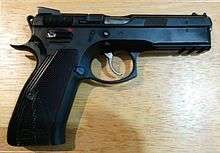 |
CZ P-07 | 9x19mm Parabellum | On limited trial. | ||
| Glock | 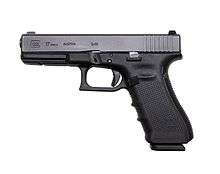 |
Glock 19 | 9x19mm Parabellum | Used by officers tasked in UN peacekeeping and Police Coast Guard roles, also by Singapore Prison Service. Will replace the Taurus revolver used by other frontline units. | ||
| Heckler & Koch USP | _modified.jpg) |
H&K USP Compact | 9x19mm Parabellum | Used by Police Special Operations Command and Central Narcotics Bureau Special Task Force. | ||
| Sphinx 3000 | 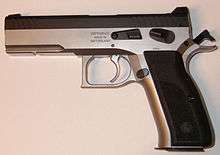 |
Sphinx 3000 | 9×19mm Parabellum | Used by units of the Police Special Operations Command | ||
| Taurus Model 85 |  |
Model 85 | .38 Special | Will be phased out. | ||
| Shotguns | ||||||
| Remington 870 | 870 MCS 870 Police Magnum |
12 gauge | Used by Gurkha Contingent and Police Special Operations Command, | |||
| Benelli M3 | 12 gauge | Used by Police Coast Guard Special Task Squadron. | ||||
| Submachine Guns | ||||||
| Heckler & Koch MP5 | 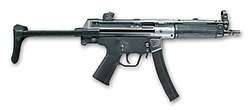 |
MP5A3 MP5A2 MP5K-PDW |
9x19mm Parabellum | Standard sub-machine gun used by Protective Security Command, Gurkha Contingent and all units of the Police Special Operations Command. | ||
| Assault Rifles | ||||||
| FN SCAR | 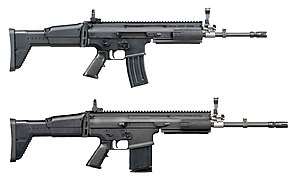 |
FN MK 16 CQC FN MK 16 LB |
5.56×45mm NATO | Standard assault rifle used by Gurkha Contingent and units of the Police Special Operations Command, such as STAR unit and PTU. | ||
| Colt M4 Advanced Piston Carbine | Colt LE6940P | 5.56×45mm NATO | Used by Police Coast Guard Special Task Squadron and Emergency Response Team. | |||
| M16 | M16A1 M16A2 |
5.56×45mm NATO | Used by Gurkha Contingent and Emergency Response Teams. Also used as a ceremonial rifle. | |||
| M16S1 | M16S1 | 5.56×45mm NATO | Used by Gurkha Contingent and Emergency Response Teams. Also used as a ceremonial rifle with a bayonet attached. | |||
| Machine Guns | ||||||
| FN MAG | 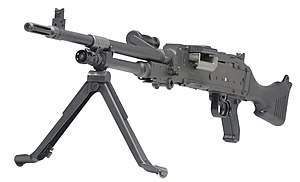 |
STK MAG 60.20 | 7.62×51mm NATO | Used by the Gurkha Contingent and Police Coast Guard. Mounted on PCG boats. | ||
| FN Minimi |  |
Minimi Para | 5.56×45mm NATO | Used by Gurkha Contingent. | ||
| STK 50MG | 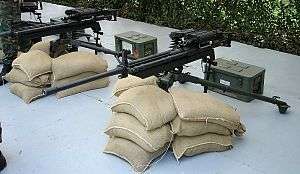 |
STK 50MG | .50 BMG | Used by PCG. Mounted on STK ADDER RCWS onboard Patrol Interdiction Boats and other PCG boats. | ||
| M2 Browning |  |
FN M2HB-QCB | .50 BMG | Used by PCG. Mounted on STK ADDER RCWS onboard Patrol Interdiction Boats. | ||
| Sniper Rifles | ||||||
| Accuracy International Arctic Warfare | Arctic Warfare Police | 7.62×51mm NATO | Used by STAR and Gurkha Contingent snipers. | |||
| Grenade Launchers | ||||||
| Heckler & Koch HK69A1 | HK69A1 | 40 mm grenade | Used by Police Tactical Unit of the Police Special Operations Command. | |||
| Autocannons | ||||||
| M242 Bushmaster | _ejects_casings_d.jpg) |
Mk 38 Mod 2 | 25 mm caliber | Used by the Police Coast Guard. Mounted on the Typhoon Weapon Station onboard PCG boats. | ||
| 20mm Oerlikon | 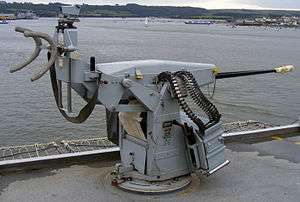 |
20mm caliber | Used by the Police Coast Guard. Mounted onboard PCG boats. | |||
| Non-Lethals | ||||||
| TASER X26 |  |
X26P | Electrodes | Use by all units of the police. | ||
| FN 303 | Used by SPEAR teams of the Singapore Prison Service | |||||
| FN 303-P | Used by SPEAR teams of the Singapore Prison Service | |||||
| Pepperball VKS | Used by Police Tactical Unit of the Police Special Operations Command | |||||
| Pepperball TAC700 | Used by SPEAR teams of the Singapore Prison Service | |||||
| Pepperball TAC-SF | Used by SPEAR teams of the Singapore Prison Service | |||||
Retired Weapons
- Sterling Mk IV SMG
- Sten Mk IV SMG
- Lee-Enfield No.4 Mk II bolt-action rifle
- FN FAL / L1A1 Self-Loading Rifle
- Webley Mk IV .38 revolver
- Uzi SMG
- Mini Uzi carbine
- Federal Riot Gun
Vehicles

Land division officers typically patrol and respond to calls in vehicles known as the Fast Response Car (FRC).[50] Car models that have been used by the SPF include the Subaru Impreza TS 1.6.[51]
In 2005, the SPF introduced the new Fast Response Vehicle (FRV),[52] consisting of modified Toyota Hi-Lux sport utility vehicles with a back compartment to carry equipment.[51]
In 2009, the SPF introduced Forward Command Vehicles.[53] These were replaced in 2017 by Division Command Vehicles with greater mobility designed to enhance command, control and coordination.[54] In addition, the SPF introduced new unmanned aerial vehicles with red and blue siren lights, a searchlight, a high-definition camera and an audio warning system. The UAVs are controlled by two-man teams (consisting of a pilot and a safety officer) and are designed to conduct search and rescue operations, attending public order incidents, traffic management, hostage situations and crowd monitoring.[54]
Police from the Community Policing Units may also patrol in residential neighbourhoods on bicycles.[55] At the 2007 Singapore National Day Parade, the Singapore Police Force unveiled a Tenix S600 APC (Armored Personnel Carrier) had been purchased for its operations for the Special Operations Command, and in NDP 2015, the Achleitner HMV Survivor and the Gurkha MPV by Terradyne Armored Vehicles Inc was unveiled.
The various specialist units may also make use of other specialised equipment specific to their scope of duty
Other vehicles used by the various units include:
Land Divisions
- Toyota Corolla Altis
- Hyundai Elantra
- Hyundai Avante
- Chevrolet Cruze
- Chevrolet Captiva
- Ford Everest
- Hyundai Sante Fe
- Hyundai H1 Starex
- Mercedes-Benz Sprinter
- Mercedes-Benz Vito
- Land Rover Defender
- Nissan Navara - Van
- Nissan Urvan - Van
- Toyota Hilux - Pickup truck
- Isuzu D-Max - Pickup truck
- Mitsubishi L200 - Pickup truck
- Volvo V70XC - SUV
Police Security Command
- Volvo XC60 - SUV
- Volvo S90 - Sedan
- Volvo S80 - Sedan
- Mitsubishi Pajero - SUV
Traffic Police
- Yamaha Diversion XJ900P - Motorbike
- Volvo S80 - Sedan
- Subaru Impreza - Sedan
- BMW 335d - Sedan
- Iveco Daily - Van
Special Operations Command
- Franz Achleitner HMV Survivor I (STAR) - Armoured personnel carrier
- Shorland S600 (STAR) - Armoured personnel carrier
- Scania Rosenbauer (PTU) - Water cannon truck
- Mercedes-Benz Atego 1023A (PTU) - Armoured vehicle
- Mercedes-Benz Sprinter 516 CDI (STAR, PTU, K9) - Van
- Mercedes-Benz Sprinter 416 CDI (K9)- Van
- Mercedes-Benz Sprinter 413 CDI (K9) - Van
- Ford Transit Jumbo (ERT, PTU) - Tactical response van
- Toyota Land Cruiser (STAR) - Tactical response SUV
- Mitsubishi Pajero (STAR) - Tactical response SUV
- BMW F800 GS - (RDT) - Motorbike
- MAN TGA 26.320 - Forward command vehicle
Gurkha Contingent
- Terradyne Armored Vehicles Gurkha MPV - Armoured personnel carrier
- Land Rover Defender Bull Fighter - Armoured personnel carrier
- Land Rover 110 Defender- 4WD
Criminal Investigation Department
- Mercedes Benz Vito - Van
Prison Service
- Nissan Diesel - Bus
- Isuzu S7 - Bus
- Toyota Coaster - Bus
- Fiat Ducato - Van
- Iveco Daily - Van
- Toyota Hiace- Van
- Toyota Hilux - Pickup truck
- SPF Police Vehicles
_1.6_Elite_sedan%2C_Singapore_Police_Force_(2016-01-03).jpg) Fast Response Car Hyundai Elantra in use by the SPF
Fast Response Car Hyundai Elantra in use by the SPF A Ford Everest used by the SPF
A Ford Everest used by the SPF.jpg) A Toyota Hilux used by the SPF
A Toyota Hilux used by the SPF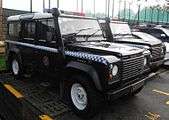 Land Rover Defender
Land Rover Defender Volvo V70XC
Volvo V70XC- Subaru Impreza Fast Response Car used by the SPF
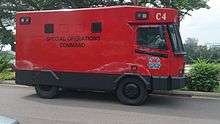 Vehicle used by the Special Operations Command
Vehicle used by the Special Operations Command CSI van used by Scene-of-Crime officers at the land divisions
CSI van used by Scene-of-Crime officers at the land divisions
Decommissioned
Defunct divisions and establishments
- Old Police Academy (01°19′47″N 103°50′11″E) - vacated in 2006, relocated to Old Choa Chu Kang Road as part of the Home Team Academy, leaving behind the Police National Service provost unit and Traffic Police driving test school. The accommodation barracks and training facilities of the Old Police academy currently houses the training departments for all auxiliary police forces in Singapore.
- Geylang Police Division (01°19′35″N 103°53′26″E) defunct 'C' Division HQ - closed and vacated in 2000, areas of responsibility was divided between 'A', 'F' & 'G' Divisions. Station's status - Currently in use by Geylang NPC under 'G' Bedok Police Division and by Public Transport Security Command.
- Toa Payoh Police Division (01°20′23″N 103°51′0″E) defunct 'B' Division HQ - closed and vacated in 1988, areas of responsibility was divided between 'E' & 'F' Divisions. Station was refurbished and is currently in use by Security Command.
Land Divisions
- Beach Road Police Station (01°17′50″N 103°51′26″E) - former site of 'A' Division HQ, vacated in 2000.
- Eu Tong Sen Street Police Station (01°16′59″N 103°50′29″E) - former HQ site of CAD, CID & VSC since 1994, vacated in 2001 and was transferred to the charge of SLA. Station status pending.
- Joo Chiat Police Station (01°18′19″N 103°54′15″E) - former site of 'G' Division HQ, vacated in 1987 and was transferred to the charge of SLA, which in turn released the premises for use by private developers.
- Old Hill Street Police Station (01°17′26.61″N 103°50′53.31″E) - vacated in 1980, this old police station and barracks was renovated in 1983 and became part of MCCY and MCI.
- Paya Lebar Police Station (01°21′06″N 103°52′34″E) - former site of 'F' Division HQ, vacated in 1987, now became 2nd Division HQ SCDF.
- Queenstown Police Station (01°17′49″N 103°47′58″E) - former site of 'D' Division HQ, vacated in 1988, now became 1st Division HQ SCDF.
- Orchard Police Station - former site of 'E' Division HQ, demolished in 1983, now became ION Orchard and Orchard MRT station.
- Old Tanglin Police Station (01°18′21″N 103°49′20″E) - former site of 'E' Division HQ, vacated in 2001, now became Interpol Global Complex for Innovation.
- Taman Jurong Police Station (01°19′38″N 103°43′14″E) - vacated in 1980 and demolished in 1988, the surrounding land at the site has been redeveloped as a HDB housing precinct.
- Ama Keng Neighbourhood Police Post (01°24′12″N 103°42′5″E) sited directly across the road from Ama Keng Chinese Temple in Lim Chu Kang, the station was closed and demolished in 1980, currently replaced by a military training area.
- Bukit Panjang Neighbourhood Police Post (old)
- Pasir Panjang Neighbourhood Police Post (old) (01°17′30″N 103°46′6″E) - closed and vacated in 1986 following the inauguration of Pasir Panjang NPP & West Coast NPP. Demolished in 1991, the surrounding land at site was redeveloped as a private condominium - The Spectrum.
- Woodlands Neighbourhood Police Post (01°26′38″N 103°46′13″E) - closed in 1999 (located within the old Woodlands Checkpoint building since 1980), Woodlands Neighbourhood Police Centre has since taken over its duty.
- Kranji Neighbourhood Police Post (01°26′10″N 103°45′3″E) - closed and vacated in 1997 following the inauguration of Yew Tee NPP, building was demolished for land clearing to build factory.
Police Coast Guard
- Kallang Regional Base (01°18′15″N 103°52′16″E) - vacated in 2007, relocated to Brani Regional Base at Pulau Brani, now occupied by National Cadet Corps (Sea) Kallang Sea Training Centre.
- Jurong Regional Base (01°18′31″N 103°42′39″E) - vacated in 1999, relocated to Gul Regional Base, base was demolished to make way for the Jurong Island Highway.
- Pulau Sakeng Police Post (01°12′36″N 103°46′41″E) - closed and vacated in 1987 after the last islander left, the island was subsumed by the land reclamation process of the nearby Pulau Semakau. The Semakau landfill receiving station was built on top of the island after the reclamation process.
- Seletar Regional Base - vacated in 2005, relocated to Loyang Regional Base, base was demolished to make way for the Seletar Aerospace Park.
Dealing with offences committed by officers
Police officers are governed by the Police Force Act (Chapter 235)[56] and its Police Regulations (Chapter 235, Section 28 and 117)[57] of the Singapore Statutes.[58]
Moreover, the disciplinary offences can be found in its schedule.[59] Misfeasance and malfeasance such as blue wall of silence, conduct prejudicial to good order and discipline, corruption, misconduct and malicious prosecution[60][61][62] are referred to the Internal Affairs Office (IAO).[63]
Furthermore, the Attorney-General's Chambers (AGC) can be consulted to advise the Police on its disciplinary proceedings.[64]
Additionally, police officers can whistleblow their colleagues' official misconducts and wrongdoings by filing official police reports themselves to officially open investigation papers against lawless officers of the law.[65][66][67][68] [69][70]
In addition, police full-time national servicemen are also subjected to the Police (Special Constabulary) Regulations (Chapter 235, Section 85).[71]
SPF HQ spokesperson routinely issues official statements stating that its officers are not only expected to uphold the law, but also to maintain the highest standards of conduct and integrity.[70] The spokesperson added that SPF deals severely with officers who break the law, including charging them in court.[69] Also, SPF usually commence disciplinary proceedings against the officers involved, and as well as suspend them pending internal investigations.
Notable cases
In March 1976,[72] one of Singapore's top prominent senior lawyers, the late Subhas Anandan, was arrested by a corrupted policeman for suspected involvement in a secret society under the Criminal Law (Temporary Provisions) Act.[73][74][75] He was remanded without trial in a prison for a few months. Subhas was exonerated and acquitted in November of the same year, following an investigation probe by the Corrupt Practices Investigation Bureau.[76]
On 10 July 2013, ex-policeman Senior Staff Sergeant Iskandar Rahmat — a 14-year veteran award-winning investigation officer — killed a car workshop owner and the man’s son, and has since been on the death row from 2017 onward, after failing in his appeal and president clemency against the death sentence.[77]
Media outreach efforts
Through the Media Communication Division of the Public Affairs Department, SPF has collaborated with the media industry to produce content that supports and promote the mission and brand of the organisation.[78]
Books
- In the service of the nation, 1985
- 999: True Cases from the CID, 1987
- Service to the Nation: 50 years of the Volunteer Special Constabulary, 1998
- Policing Singapore in the 19th & 20th centuries, 2002
- Justice is Done, 2005
- The Adventures of Constable Acai, 1987: A series of crime stories, based on actual crimes from police files were compiled into storybooks from the popular children's magazine Young Generation, about the adventures of a fictional policeman named Constable Acai. They were written by officers from the Crime Prevention Department to instill crime awareness in children during the '80s through to the mid-'90s. The other books in this series are as below:
- More Adventures of Constable Acai, 1989
- Constable Acai Fights Crime, 1996
Novels
- Operation Firestorm, 1997
- Singapore Police Magazine
- Police Life, 1971 to present
- Police Life Annual
Television programs
- Documentary
- Crimewatch, 1986–Current
- True Files, 2002–2007
- Drama Series
- Seletar Robbery (实里达大劫案), 1982
- CID '83, 1983
- First Step (踏上征途), 1986: On women in the police force
- Patrol (铁警雄风), 1989: A take on the lives of the men in the Traffic Police Department
- Private Eyes (妙探智多星), 1991
- Ladies in action (霹雳红唇), 1992
- Crime and Passion (執法先鋒), 1992
- Lethal Duo (天使追辑令), 1994
- Dr Justice (法医故事), 1994
- Neighbourhood Heroies (大英雄小人物), 1995
- Triple Nine, 1995-1998: On the adventures of a CID team.
- Secret Files (机密档案), 1995
- The Shadow Mission (地下猎人), 1995
- The Dragons Five (飞龙五将), 1995
- Dr Justice II (法医故事II), 1996
- City Cops (警网双雄), 1996
- Of Cops And Men (城市双雄), 1996
- Pursuit of Justice (石破天惊), 1997
- Act 235 (刑事235), 1998
- Dare To Strike (扫冰者), 14 November 2000: the phrase "Dare to Strike" is the motto of the Central Narcotics Bureau
- The Reunion (顶天立地), 26 December 2001
- Heartlanders, 2002-2005: On two Neighbourhood Police Centre officers
- True Heroes (真心英雄), 5 May 2003: On a rookie Neighbourhood Police Centre officer
- The Frontline (家在前线), 2003: This fictional six-part TV show depicts how Singaporeans cope after the German mastermind of a neo-anarchist organisation sets off a bomb at a naval base as an anti-imperialistic statement against Singapore's ties with the United States. It showcases the capabilities of the Singapore Police Force and the Singapore Armed Forces to deal with terrorism. Many technologies introduced in this series has never been before shown to the public. It is also the only local television series to date to accurately depict the Police's elite Special Tactics and Rescue (STAR) team and the Army's Special Operations Forces (SOF) although the latter unit was never addressed by name in the show. They were instead referred to as "The Commandos".
- When the Time Comes (一线之间), 2004
- The Crime Hunters (心网追凶), 2004
- Police & Thief, 2004–2010
- Life Line, 2005–2007
- Zero to Hero (阴差阳错), 2005
- Without Warning, 2006
- The Undisclosed (迷云二十天), 2006
- C.I.D. (刑警2人组), 12 June 2006
- Metamorphosis (破茧而出), 18 September 2007
- Crime Busters x 2 (叮当神探), 30 September 2008
- Unriddle (最火搭档), 2010
- Vettai : Pledged to Hunt (வேட்டை), 23 November 2010 – 30 March 2011
- C.L.I.F. (警徽天职), 2011: First drama to be produced in close collaboration with the Singapore Police Force. The second, third, fourth, and fifth seasons were aired in 2013, 2014, September 2016 and September 2019 respectively.
- Unriddle 2 (最火搭档2), 2012
- Vettai 2.0: The Next Generation (வேட்டை 2.0), 4 January 2012 – 11 May 2013
- Vettai 3: The Final Judgement (வேட்டை 3), 17 November 2014 – present
- Mata-Mata Season 1, 2013: background post-World War II in Singapore and establish woman police
- Mata-Mata Season 2, 2014: A New Era, background after separation Singapore from Malaysia and secret society '70s
- Mata-Mata Season 3, 2016: A New Generation, background development Singapore and crime late '70s,early '80s and now
Movies
- The Last Blood (驚天十二小時), 1991
- Ace Cops (妙警点三八), 1996: Telemovie
- Life on the Line (魂断四面佛), 1996: Telemovie
- 2000 AD (公元2000), 1999[79]
- After School (放学后), 2004: A film released by the National Crime Prevention Council to harness the power of cinema as a public education tool to reach out to young Singaporeans and their families.
See also
| Wikimedia Commons has media related to Singapore Police Force. |
References
Notes
- "Archived copy". Archived from the original on 24 September 2015. Retrieved 18 August 2015.CS1 maint: archived copy as title (link)
- "Singapore Police Force Annual 2018". Singapore Police Force. Singapore Police Force. p. 67. Retrieved 18 November 2018.
- "Singapore PUBLIC ORDER AND INTERNAL SECURITY - Flags, Maps, Economy, History, Climate, Natural Resources, Current Issues, International Agreements, Population, Social Statistics, Political System". Archived from the original on 17 January 2008. Retrieved 15 January 2008. The Police Force Act, Chapter 235 of Singapore provides for the constitution, administration, powers and discipline of the force.
- "Archived copy". Archived from the original on 4 July 2019. Retrieved 28 July 2019.CS1 maint: archived copy as title (link)
- https://www.police.gov.sg/Who-We-Are/Values
- "New Phoenix Park". Ministry of Home Affairs. Year 2001. Archived from the original on 5 August 2016. Retrieved 2 May 2015.CS1 maint: location (link)
- Farquhar to Raffles, 5 May 1820, L.10, Straits Settlement Records.
- Farquhar to Raffles, 2 November 1819, L. 10, Straits Settlement Records.
- Jennings to Farquhar, 15 August 1820, L. 4, Straits Settlement Records.
- "Singapore - Gun Facts, Figures and the Law". GunPolicy.org. Archived from the original on 30 April 2015. Retrieved 2 May 2015.
- "Murder rate low, but S'poreans still rattled". Archived from the original on 4 January 2015. Retrieved 27 December 2014.
- "Archived copy". Archived from the original on 18 November 2018. Retrieved 17 November 2018.CS1 maint: archived copy as title (link)
- "Administration and Finance Department". Singapore Police Force. Archived from the original on 4 July 2019. Retrieved 10 February 2020.
- "Centre for Protective Security". Singapore Police Force. Archived from the original on 4 July 2019. Retrieved 30 December 2018.
- "Community Partnership Department". Singapore Police Force. Archived from the original on 4 July 2019. Retrieved 30 December 2018.
- "Inspectorate and Compliance Office". Singapore Police Force. Archived from the original on 4 July 2019. Retrieved 30 December 2018.
- "Internal Affairs Office". Singapore Police Force. Archived from the original on 4 July 2019. Retrieved 30 December 2018.
- "International Cooperation Department". Singapore Police Force. Archived from the original on 4 July 2019. Retrieved 30 December 2018.
- "Manpower Department". Singapore Police Force. Archived from the original on 4 July 2019. Retrieved 30 December 2018.
- "Operations Department". Singapore Police Force. Archived from the original on 4 July 2019. Retrieved 30 December 2018.
- "Planning and Organisation Department". Singapore Police Force. Archived from the original on 4 July 2019. Retrieved 30 December 2018.
- "Police Licensing and Regulatory Department". Singapore Police Force. Archived from the original on 4 July 2019. Retrieved 30 December 2018.
- "Police Logistics Department". Singapore Police Force. Archived from the original on 4 July 2019. Retrieved 30 December 2018.
- "Police National Service Department". Singapore Police Force. Archived from the original on 4 July 2019. Retrieved 30 December 2018.
- "Public Affairs Department". Singapore Police Force. Archived from the original on 4 July 2019. Retrieved 30 December 2018.
- "Service Delivery Department". Singapore Police Force. Archived from the original on 4 July 2019. Retrieved 30 December 2018.
- "Training & Capability Development Department". Singapore Police Force. Archived from the original on 4 July 2019. Retrieved 30 December 2018.
- "Volunteer Special Constabulary". Singapore Police Force. Archived from the original on 4 July 2019. Retrieved 30 December 2018.
- "Commercial Affairs Department". Singapore Police Force. Archived from the original on 31 December 2018. Retrieved 30 December 2018.
- "Criminal Investigation Department". Singapore Police Force. Archived from the original on 20 January 2019. Retrieved 30 December 2018.
- "Ops-Tech Department". Singapore Police Force. Retrieved 10 February 2020.
- "Police Intelligence Department". Singapore Police Force. Archived from the original on 28 May 2017. Retrieved 30 December 2018.
- "Ministry of Home Affairs Annex 2015" (PDF). Singapore Budget. Ministry of Finance. Archived (PDF) from the original on 28 March 2016. Retrieved 21 December 2015.
- "Analysis of Revenue and Expenditure FY2015" (PDF). Singapore Budget. Archived (PDF) from the original on 6 March 2016. Retrieved 21 December 2015.
- "Ministry of Home Affairs FY2015 Expenditure Estimates" (PDF). Singapore Budget. Ministry of Finance. Archived (PDF) from the original on 9 March 2016. Retrieved 21 December 2015.
- "Singapore Police Force—Police Officer Entry Requirements". Spf.gov.sg. Archived from the original on 20 November 2008. Retrieved 30 May 2013.
- "Singapore Police Force—Senior Police Officer Entry Requirements". Spf.gov.sg. Archived from the original on 9 December 2008. Retrieved 30 May 2013.
- "Retention bonus for police". Asiaone.com. Archived from the original on 8 December 2008. Retrieved 30 May 2013.
- "Singapore Police Force—Police Officer Training and Postings". Spf.gov.sg. Archived from the original on 20 November 2008. Retrieved 30 May 2013.
- "Singapore Police Force—Senior Police Officer Training and Postings". Spf.gov.sg. Archived from the original on 20 November 2008. Retrieved 30 May 2013.
- "Police Officer". More than Just a Job. Singapore Police Force. Archived from the original on 17 December 2015. Retrieved 21 December 2015.
- "Senior Police Officer". More than Just a Job. Singapore Police Force. Archived from the original on 17 December 2015. Retrieved 21 December 2015.
- "About - Volunteer Special Constabulary". Archived from the original on 20 September 2014. Retrieved 17 September 2014.
- "Civilian Careers". More Than Just a Job. Singapore Police Force. Archived from the original on 17 December 2015. Retrieved 21 December 2015.
- Mahmud, Aqil Haziq (11 April 2018). "Police officers in Singapore to get new uniforms". Channel NewsAsia. Archived from the original on 1 January 2019. Retrieved 1 January 2019.
- "RANKS AND DRILL COMMANDS". cmpb.gov.sg. Archived from the original on 29 December 2018. Retrieved 28 December 2018.
- Leong Wai Kit (22 June 2016). "Changes to police officers' ranks kick in from July". Channel NewsAsia. Archived from the original on 26 November 2018. Retrieved 28 December 2018.
- https://www.cmpb.gov.sg/web/portal/cmpb/home/life-in-ns/spf/ranks-and-drill-commands
- https://www.straitstimes.com/singapore/he-will-finally-be-an-inspector-thanks-to-scheme
- "A day in the life of a Neighbourhood Police officer". AsiaOne. 18 November 2018. Archived from the original on 29 December 2018. Retrieved 29 December 2018.
- "SPF's New Fleet Hits the Road". Archived from the original on 4 June 2007. Retrieved 14 November 2018.
- "Home Team Departments" (PDF). Archived from the original (PDF) on 21 February 2007. Retrieved 14 November 2018.
- Chan, Rachel (17 April 2009). "Spike in loanshark harassment cases". my paper. Archived from the original on 25 January 2017. Retrieved 29 December 2018.
- Mahmud, Aqil Haziq (31 December 2017). "New drones, command vehicles to help police fight crime better". Channel NewsAsia. Archived from the original on 15 June 2018. Retrieved 29 December 2018.
- Mohamed Yusof, Zaihan (22 October 2018). "Community police walking, cycling to keep neighbourhoods safe". The Straits Times. Archived from the original on 29 December 2018. Retrieved 29 December 2018.
- https://sso.agc.gov.sg/Act/PFA2004
- https://sso.agc.gov.sg/SL/PFA2004-RG1
- https://sso.agc.gov.sg/
- https://sso.agc.gov.sg/Act/PFA2004?ProvIds=Sc-#Sc-
- "False charge of offence made with intent to injure". Singapore Statutes. Singapore Statutes. 22 June 2020.
- https://ink.library.smu.edu.sg/sol_research
- http://ink.library.smu.edu.sg/sol_research/933
- https://www.police.gov.sg/Who-We-Are/Organisation-Structure/Staff-Departments
- "Overview of Functions". Attorney-General's Chambers. Attorney-General's Chambers. 16 June 2020.
- https://www.straitstimes.com/singapore/courts-crime/cop-who-damaged-walking-stick-belonging-to-cancer-survivor-jailed-for-lying
- https://www.straitstimes.com/singapore/courts-crime/cop-jailed-for-lying-committing-mischief
- https://www.straitstimes.com/singapore/courts-crime/cop-convicted-of-damaging-walking-stick-belonging-to-parrot-man-and-then
- https://www.straitstimes.com/singapore/courts-crime/body-cam-catches-cop-in-lie-about-damaging-walking-aid
- https://www.straitstimes.com/singapore/courts-crime/senior-police-officer-who-made-crude-remarks-about-subordinate-fined-6000-for
- https://www.straitstimes.com/singapore/courts-crime/police-officer-fined-for-crude-remarks-about-subordinate
- https://sso.agc.gov.sg/SL/PFA2004-RG3
- "Lawyer Subhas acquitted". The Straits Times. 22 February 1976. p. 9.
- "What it should have been". The Straits Times. 18 January 1997. p. 2.
- "2011 U@Live featuring Subhas Anandan". National University of Singapore. Archived from the original on 27 May 2015. Retrieved 10 January 2015.
- "Subhas case: CPIB probe". The Straits Times. 22 March 1976. p. 7.
- Tay, Mark (2 December 2013). "Subhas Anandan". Esquire Singapore.
- http://www.todayonline.com/singapore/kovan-double-murder-high-court-dismisses-ex-cops-appeal-his-lawyers-face-disciplinary
- "Staff Departments". Singapore Police Force. Retrieved 15 March 2020.
- "Aaron Kwok stole police car in S'pore?". Lianhe Zaobao. 22 November 1999.
Bibliography
- "In the Service of the Nation", John Drysdale, Federal Publications, 1985 ISBN 9971-4-0703-5
- "Phoenix: the story of the Home Team ", Felix Soh, Times Editions, 2003 ISBN 981-232-637-5
- "Policing Singapore in the 19th & 20th centuries", Peer M. Akbur, Singapore Police Force, 2002 ISBN 981-04-7024-X
- "Singapore Police Force Annual", Singapore Police Force, several editions
External links
- Singapore Police Force on Facebook
- Library resources in your library and in other libraries about Singapore Police Force
- Organisation, Recruitment, and Training of Police
- Public Order and Internal Security (1989)
- Training the Police
- Police-related Singapore news
- Crossing the generation gap
